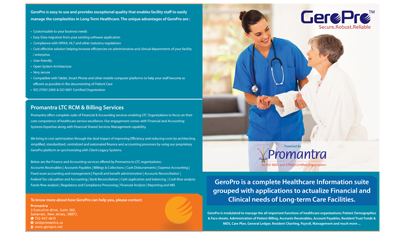How SNFs Can Prepare for Financial Uncertainty

Skilled Nursing Facilities (SNFs) operate in a financially challenging environment, facing reimbursement cuts, rising operational costs, regulatory changes, and economic downturns. Without a strategic approach to financial planning, SNFs risk cash flow disruptions, compliance penalties, and even closure. To maintain long-term stability, SNFs must adopt proactive financial strategies to navigate uncertainties and ensure sustainable operations. This blog explores best practices for financial resilience, including cost control, revenue diversification, regulatory compliance, and technology adoption.
1. Understanding the Financial Risks Faced by SNFs
Financial uncertainty in SNFs arises from various factors, including:
- Reimbursement Cuts: Reductions in Medicare and Medicaid payments can strain cash flow.
- Rising Operational Costs: Increasing labor, insurance, and supply expenses reduce profit margins.
- Regulatory Changes: Shifts in CMS policies and compliance requirements impact revenue streams.
- Economic Downturns: Recessions may lead to lower census rates and reduced private pay admissions.
- Pandemics and Public Health Crises: Unexpected health emergencies increase costs for PPE, infection control, and additional staffing.
Case Study: A Midwest SNF faced severe financial strain during the COVID-19 pandemic due to rising labor costs and delayed reimbursements. By leveraging cost-cutting strategies and telehealth billing, they managed to reduce expenses by 20% and maintain operational stability.
Key Takeaway: Identifying potential financial risks allows SNFs to implement preventative measures and contingency plans.
2. Strategies for Financial Resilience
To withstand financial uncertainty, SNFs must adopt a multi-faceted financial strategy. Below are key approaches for strengthening financial resilience.
2.1 Strengthening Revenue Cycle Management (RCM)
Efficient RCM processes ensure timely reimbursements and minimize revenue losses.
How to Optimize RCM:
- Implement automated billing systems to reduce claim errors.
- Use predictive analytics to identify trends in reimbursement delays.
- Train staff on accurate coding and documentation to prevent claim denials.
- Monitor Accounts Receivable (AR) closely to improve cash flow.
Example: A Florida SNF reduced claim denials by 35% by adopting an AI-powered billing system that flagged incomplete claims before submission.
Key Takeaway: Investing in billing automation and staff training reduces errors and accelerates reimbursement timelines.
2.2 Controlling Operational Costs Without Compromising Care
Controlling expenses is crucial for financial sustainability, but cost-cutting should not affect the quality of care.
Cost Reduction Strategies:
- Workforce Optimization: Use AI-driven scheduling tools to manage staffing efficiently.
- Energy Efficiency: Reduce utility costs with LED lighting, energy-efficient HVAC, and water conservation.
- Bulk Purchasing and Vendor Negotiation: Leverage group purchasing organizations (GPOs) for discounts.
- Preventive Maintenance: Regular equipment maintenance avoids costly emergency repairs.
Case Study: A Texas-based SNF saved $500,000 annually by implementing energy-efficient solutions and renegotiating supply contracts.
Key Takeaway: Small operational changes can significantly reduce costs without affecting patient care.
2.3 Building a Stronger Financial Reserve
A financial cushion helps SNFs navigate economic downturns and unexpected expenses.
How to Build Reserves:
- Allocate 5-10% of revenue to a contingency fund.
- Reduce non-essential spending and reinvest in reserves.
- Explore short-term financing options for liquidity support.
- Example: An Ohio SNF established a $1 million reserve fund, which helped cover payroll during a three-month reimbursement delay.
Key Takeaway: Having an emergency fund prevents financial crises and ensures business continuity.
2.4 Diversifying Revenue Streams
Relying solely on Medicare and Medicaid reimbursements increases financial vulnerability. SNFs should explore additional revenue sources.
Ways to Diversify Revenue:
- Offer specialized care programs (e.g., rehabilitation, memory care, and palliative services).
- Expand telehealth services for outpatient consultations.
- Lease unused facility space to therapy clinics or specialty care providers.
- Increase private pay and insurance-based admissions.
Example: A New York SNF boosted revenue by 20% by introducing a specialized stroke rehabilitation program covered by private insurance.
Key Takeaway: Expanding service offerings creates new revenue channels and enhances financial stability.
2.5 Leveraging Technology for Financial Stability
Adopting automation and digital solutions improves efficiency and reduces overhead costs.
Tech Solutions for SNFs:
- Electronic Health Records (EHRs): Improve documentation accuracy and billing efficiency.
- Automated Payroll and Scheduling Software: Reduce overtime costs and enhance workforce management.
- AI-Powered Financial Analytics: Predict revenue trends and identify cost-saving opportunities.
Example: A California SNF cut labor costs by 15% after implementing AI-driven workforce scheduling to reduce excessive overtime.
Key Takeaway: Digital transformation enhances financial efficiency and streamline operations.
3. The Role of LTCPro in Financial Preparedness
LTCPro is comprehensive financial management software designed for Skilled Nursing Facilities. It helps SNFs navigate financial uncertainty through automation, analytics, and compliance tracking.
How LTCPro Helps:
- AI-Powered Billing and Claims Processing: Reduces denial rates and accelerates reimbursements.
- Expense and Payroll Management: Optimizes staffing costs and prevents overspending.
- Predictive Financial Analytics: Forecasts cash flow trends and identifies risks.
- Compliance Automation: Ensures adherence to Medicare, Medicaid, and CMS regulations.
Case Study: A Tennessee SNF increased revenue by 25% using LTCPro’s automated revenue cycle management and predictive analytics.
Key Takeaway: LTCPro helps SNFs maintain financial stability through advanced automation and real-time insights.
Financial uncertainty is an unavoidable challenge for Skilled Nursing Facilities. However, proactive financial strategies such as optimizing revenue cycles, controlling costs, diversifying income, and leveraging technology can safeguard SNFs against economic downturns and reimbursement cuts.
Key Takeaways:
- Automating revenue cycle management reduces claim denials and improves cash flow.
- Cost control strategies help maintain profitability without sacrificing care quality.
- Building financial reserves ensures stability during unexpected crises.
- Diversifying revenue sources creates additional income streams for SNFs.
LTCPro provides AI-driven financial management solutions to enhance operational efficiency.
If you are looking to strengthen your SNF’s financial future, consider exploring how LTCPro can assist you.
A perfect fit for Skilled Nursing Facilities, Assisted Living Facilities, Home Health, Hospice and Other Day Care Centres.
Download BrochureRequest a demo


























